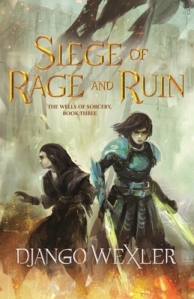Title: Siege of Rage and Ruin
Series: Wells of Sorcery #3
Author: Django Wexler
Genre: Fantasy
Trigger Warnings: Death (severe), blood, violence (severe), injury (severe), gore (mentions), war, mind control, body horror (mild), kidnapping, confinement, suicidal thoughts
Spoiler Warning: This is the third and final book in a trilogy, and reading beyond this point will expose you to spoilers of the first two books.
Back Cover:
Siege of Rage and Ruin is the explosive final adventure in Django Wexler’s The Wells of Sorcery trilogy, an action-packed epic fantasy saga.
Isoka has done the impossible–she’s captured the ghost ship Soliton.
With her crew of mages, including the love of her life Princess Meroe, Isoka returns to the empire that sent her on her deadly mission. She’s ready to hand over the ghost ship as ransom for her sister Tori’s life, but arrives to find her home city under siege. And Tori at the helm of a rebellion.
Neither Isoka’s mastery of combat magic, nor Tori’s proficiency with mind control, could have prepared them for the feelings their reunion surfaces. But they’re soon drawn back into the rebels’ fight to free the city that almost killed them.
Review:
If I had a nickel for every trilogy I’ve read about a violent teenage girl who took power from her deep rage and could sprout magical blades from her hands, I’d have two nickels. Which isn’t a lot, but it’s weird that it happened twice. What’s even weirder is that even though both trilogies are very different in idea, I loved both stories and adored both angry violent hand-blade girls.
I had fairly low expectations for this final book. I adored Ship of Smoke and Steel, but had some major struggles with City of Stone and Silence that made me severely tone down my expectations for this book. On top of that, this book brings Isoka back to Kahnzoka, leaving behind the weird and wonderful settings I loved about the last two books for an unfortunately ordinary city. So I really was not expecting to enjoy it very much.
But, surprising nobody more than myself, I enjoyed it quite a bit.
To start with, I didn’t dislike Tori nearly as much as I did last book. I can’t entirely put my finger on why, either. It’s probably a lot of factors. I have the context of her from the previous book, so she doesn’t feel like a strange new character anymore. There’s less contrast between her parts and Isoka’s, since they’re both in the same setting. There’s significantly more action, which leaves less time for romance and Tori beating herself up (there still is some, but it’s no longer her main focus). And generally, her stress over the pressure of responsibility is much more relatable than anything she did last book. I definitely liked Isoka more, but I didn’t dread Tori’s parts this time around.
Isoka is still Isoka. She’s still angry, violent, incredibly powerful, and utterly awesome. I love her so much. And being back in the city she left at the beginning of book one really emphasized her character growth. I didn’t realize how much she’d changed over the course of this trilogy, and discovering it through being back in the same context was interesting.
Now that the sisters are actually together – really for the first time in the whole series – they had an interesting sibling dynamic going on. And I related to both sides of it. I understood Tori’s frustration with growing and changing and coming into her own but Isoka expecting her not to have grown or changed at all. And I also related to Isoka’s struggles to accept that Tori has grown up and is no longer the child who needs her big sister for constant guidance and protection. (My youngest sister is in college now and I am feeling that one hard.)
Kahnzoka as a setting is significantly less interesting than Soliton or the Harbor or all the other weird and cool magical stuff Isoka has encountered throughout this series. But the story was more about the rebellion than the setting itself, so it was acceptable. There is still plenty of action and plenty of fights where Isoka gets to shine. There are less absurdly powerful protagonist moments (or the “protagonist does the impossible” variation that Isoka tends to favor), but there were still a few. There are interesting and well-developed secondary and minor characters (including Jack, who is my absolute favorite secondary character of the whole series), plenty of magic awesomeness, and some surprisingly interesting parts about the material challenges of running a rebellion.
It’s definitely not perfect. There are very few real surprises or anything new to uncover (although I didn’t mind this too much, as there was enough action to keep me interested). I got frustrated with Tori and Isoka at the beginning, because they were having some issues that could be completely solved if they actually communicated, but that was pretty much over after the beginning. Overall, despite a less-than-thrilling setting, Siege of Rage and Ruin is a solid and enjoyable conclusion to this series.
The Wells of Sorcery series:
- Ship of Smoke and Steel
- City of Stone and Silence
- Siege of Rage and Ruin

